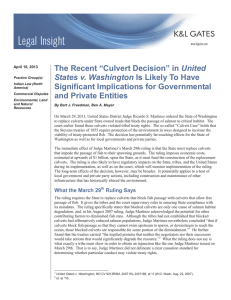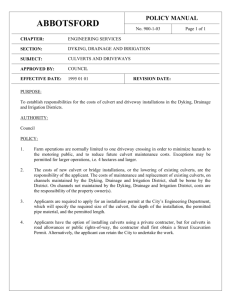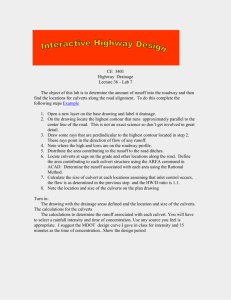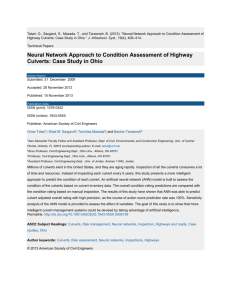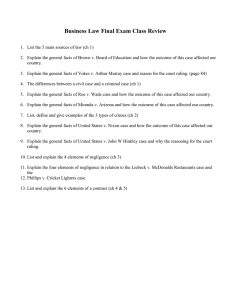CULVERT OPERATIONS CITY WISE
advertisement
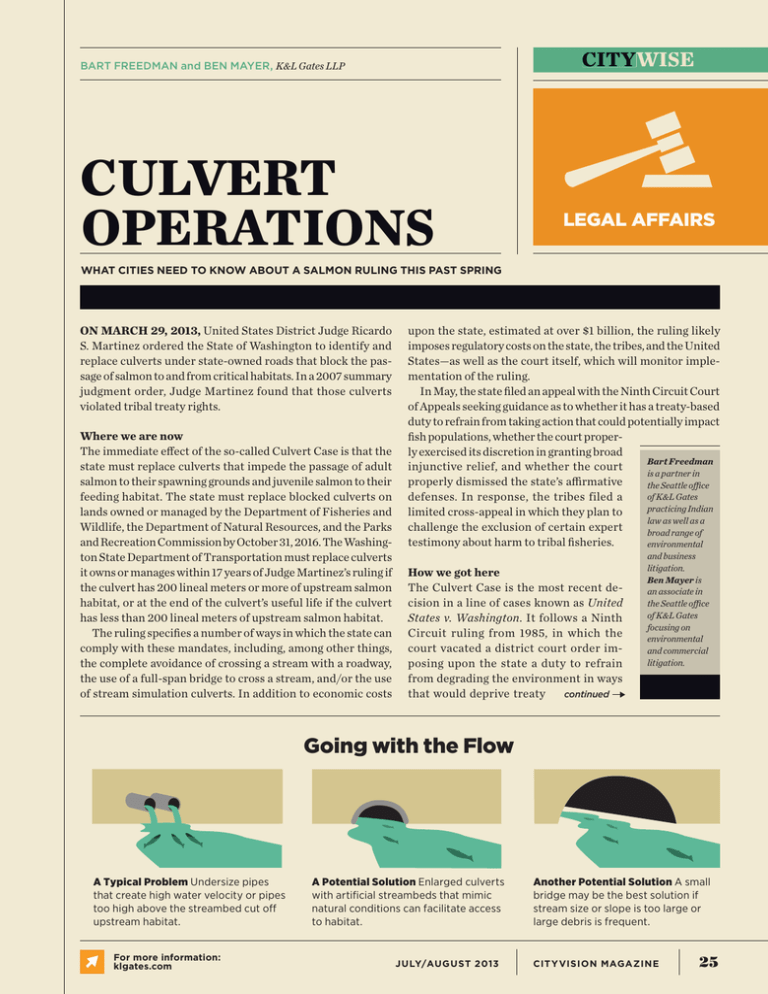
CITYWISE BART FREEDMAN and BEN MAYER, K&L Gates LLP CULVERT OPERATIONS LEGAL AFFAIRS WHAT CITIES NEED TO KNOW ABOUT A SALMON RULING THIS PAST SPRING ON MARCH 29, 2013, United States District Judge Ricardo S. Martinez ordered the State of Washington to identify and replace culverts under state-owned roads that block the passage of salmon to and from critical habitats. In a 2007 summary judgment order, Judge Martinez found that those culverts violated tribal treaty rights. Where we are now The immediate effect of the so-called Culvert Case is that the state must replace culverts that impede the passage of adult salmon to their spawning grounds and juvenile salmon to their feeding habitat. The state must replace blocked culverts on lands owned or managed by the Department of Fisheries and Wildlife, the Department of Natural Resources, and the Parks and Recreation Commission by October 31, 2016. The Washington State Department of Transportation must replace culverts it owns or manages within 17 years of Judge Martinez’s ruling if the culvert has 200 lineal meters or more of upstream salmon habitat, or at the end of the culvert’s useful life if the culvert has less than 200 lineal meters of upstream salmon habitat. The ruling specifies a number of ways in which the state can comply with these mandates, including, among other things, the complete avoidance of crossing a stream with a roadway, the use of a full-span bridge to cross a stream, and/or the use of stream simulation culverts. In addition to economic costs upon the state, estimated at over $1 billion, the ruling likely imposes regulatory costs on the state, the tribes, and the United States—as well as the court itself, which will monitor implementation of the ruling. In May, the state filed an appeal with the Ninth Circuit Court of Appeals seeking guidance as to whether it has a treaty-based duty to refrain from taking action that could potentially impact fish populations, whether the court properly exercised its discretion in granting broad Bart Freedman injunctive relief, and whether the court is a partner in properly dismissed the state’s affirmative the Seattle office of K&L Gates defenses. In response, the tribes filed a practicing Indian limited cross-appeal in which they plan to law as well as a challenge the exclusion of certain expert broad range of testimony about harm to tribal fisheries. environmental How we got here The Culvert Case is the most recent decision in a line of cases known as United States v. Washington. It follows a Ninth Circuit ruling from 1985, in which the court vacated a district court order imposing upon the state a duty to refrain from degrading the environment in ways that would deprive treaty continued and business litigation. Ben Mayer is an associate in the Seattle office of K&L Gates focusing on environmental and commercial litigation. Going with the Flow A Typical Problem Undersize pipes that create high water velocity or pipes too high above the streambed cut off upstream habitat. For more information: klgates.com A Potential Solution Enlarged culverts with artificial streambeds that mimic natural conditions can facilitate access to habitat. JULY/AUGUST 2013 Another Potential Solution A small bridge may be the best solution if stream size or slope is too large or large debris is frequent. CITY VISION MAGAZINE 25 CITYWISE Indians of their treaty-protected fish allocation. In that case, the Ninth Circuit held that it could only evaluate the claimed environmental servitude if presented with concrete facts underlying a particular dispute. Other United States v. Washington decisions create bright lines for liability. For example, courts have held that the physical invasion of treaty-protected fishing areas violates tribal treaty rights, and that tribal fisherman have a treaty right to a 50 percent share of the annual catch in western Washington. It remains to be seen, however, how Judge Martinez’s culvert ruling will translate into a liability standard that could be a framework for resolving other cases on this subject. In the culvert ruling, Judge Martinez found that barrier culverts are directly responsible for a portion of significantly diminished salmon runs. Judge Martinez also acknowledged that other factors may contribute to this diminishment, but he did not identify these additional factors. Importantly, the ruling fails to say what a tribe must show in order to obtain an injunction like the one Judge Martinez issued on March 29. That is to say, Judge Martinez did not articulate a clear standard for determining whether particular conduct amounts to a violation of treaty-protected Municipal Engineering Community & Regional Planning Building Code & Construction Compliance fishing rights. As such, the ruling leaves many questions regarding its prospective application unanswered. While the ruling clearly applies to culverts under stateowned roads, it may have wider implications. It potentially implicates tide gates, floodgates, dams, and stream-flow or river temperature changes caused by or attributable to the state, local governments, or private-party actions. It could impact the development of habitat for a number of purposes, including housing, recreational, and industrial purposes. Ultimately, the ruling’s impacts could be numerous and far-reaching. Looking ahead The state’s opening brief on appeal is due in September, with the tribes’ and the United States’ answering brief due in October. The best course of action at this point is to monitor the case as it proceeds on appeal. As the Ninth Circuit provides guidance on the standards and meaning of the Culvert Case, the state, local and tribal governments, and private parties will gain a better understanding of the ruling’s short- and long-term impacts. Ultimately, appellate court guidance is necessary for a complete understanding of how and when the ruling applies. Stay tuned. Get an ROI on Employee Training Low cost to employer Reduced turnover rates More industrious and loyal employees Municipal Engineering 1601 Fifth Avenue, Suite 500 Planning Community & Regional Municipal Seattle, WA 98101Engineering Building Code & Construction Compliance Community & Regional Planning 206.505.3400 Building Code & Construction Compliance Fifth Avenue, 1601 Fifth1601 Avenue, SuiteSuite 500500 Seattle, WA 98101 Seattle, WA 98101 206.505.3400 206.505.3400 26 CIT Y VISION MAGAZINE Find out how employers can train their workforce now: Aerospace Joint Apprenticeship Committee JULY/AUGUST 2013 www.ajactraining.org/ROI 206-764-7940

